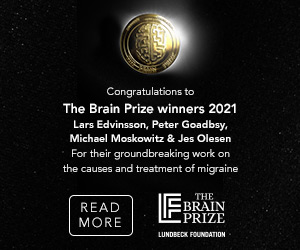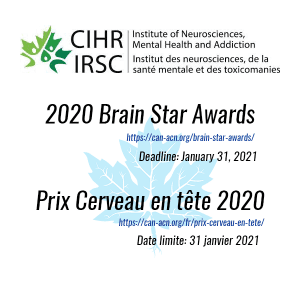Category: News
Announcing the 2020 CAN-CIHR-INMHA Brain Star Award Winners!
 The Canadian Association for Neuroscience (CAN) and the Canadian Institutes of Health’s Institute of Neurosciences, Mental Health and Addiction (CIHR-INMHA) are proud to announce the winners of the 2020 Brain Star Awards.
The Canadian Association for Neuroscience (CAN) and the Canadian Institutes of Health’s Institute of Neurosciences, Mental Health and Addiction (CIHR-INMHA) are proud to announce the winners of the 2020 Brain Star Awards.
CAN Connection Spring 2021
Read our latest newsletter: https://can-acn.org/can-connection-spring-2021
Shedding light on adult brain stem cells
 A CERVO research centre team demonstrates the role of light and calcium ions in neural stem cell activation in adulthood
A CERVO research centre team demonstrates the role of light and calcium ions in neural stem cell activation in adulthood
It has long been believed that neurons in the human brain develop only during the period from embryogenesis to adolescence. It is now known that in some areas of the brain, neural stem cells remain and give rise to neurons even in adults. “These stem cells can remain quiescent for long periods of time and we still know very little about the mechanisms that make them go from a quiescent state to an activated state,” says Armen Saghatelyan, from the Université Laval and the CERVO Brain Research Centre. Continue reading
Researchers close in on root of slow motor learning in autism

Image source uottawa.ca
Social deficits attract so much attention in the study of autism spectrum disorder, it’s easy to forget there are motor learning deficits during early childhood as well. For autistic kids hoping to throw a ball around the schoolyard and connect with classmates, these physical skill differences can isolate a child further.
In a new study published in Nature Neuroscience researchers from the University of Ottawa’s Faculty of Medicine have closed in on the neurological underpinnings of the motor learning delay. Dr. Simon Chen’s lab in the Department of Cellular and Molecular Medicine used a mouse model of autism to demonstrate a shortage in the amount of the neurotransmitter noradrenaline being released into the brain’s primary motor cortex.
Dr. Chen’s lab identified the problem originating some distance away in an area of the hindbrain called the locus coeruleus, which is known as a center of motivation, alertness, and attention.
Read the rest of the press release on the University of Ottawa website:
https://media.uottawa.ca/news/researchers-close-root-slow-motor-learning-autism
Original research article:
Yin, X., Jones, N., Yang, J. et al. Delayed motor learning in a 16p11.2 deletion mouse model of autism is rescued by locus coeruleus activation. Nat Neurosci (2021). https://doi.org/10.1038/s41593-021-00815-7
CAN Trainee research feature: Ewen Lavoie – University of Alberta
Ewen Lavoie presents work he has done in the laboratory of Dr. Craig Chapman at the University of Alberta, and published here:
Lavoie, E., & Chapman, C. S. (2021). What’s limbs got to do with it? Real-world movement correlates with feelings of ownership over virtual arms during object interactions in virtual reality. Neuroscience of Consciousness.
https://doi.org/10.1093/nc/niaa027
Pioneers in migraine research that has led to the development of new treatments awarded world’s top Brain Prize
 A group of four neuroscientists from Denmark, Sweden, UK, and USA who discovered a key mechanism that causes migraine that led to revolutionary new treatments receive The Brain Prize, the world’s most valuable prize in neuroscience.
A group of four neuroscientists from Denmark, Sweden, UK, and USA who discovered a key mechanism that causes migraine that led to revolutionary new treatments receive The Brain Prize, the world’s most valuable prize in neuroscience.
Four decades of research paved the way for the development of entirely new classes of migraine-specific drugs which are now on the market and are already radically improving the lives of sufferers.
The Brain Prize is awarded annually by the Lundbeck Foundation and is worth DKK 10 (approximately £1.1m, $1.5m, €1.3m).
The Brain Prize will be awarded at a ceremony in Copenhagen on 25 October 2021, presided over by His Royal Highness, The Crown Prince of Denmark.
CAN Connection – Winter 2021 Newsletter
Click here to read our latest newsletter:
Launch of the 2020 Brain Star Award Competition
 We are happy to announce the launch of the 2020 Brain Star Award Competition! Application deadline is January 31, 2021.
We are happy to announce the launch of the 2020 Brain Star Award Competition! Application deadline is January 31, 2021.
View all the details here: Brain Star Awards





